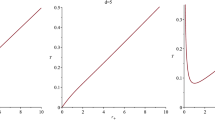Abstract
Hiscock and Weems showed that there is an attractor behavior in the evolution of asymptotically flat Reissner–Nordström black hole under Hawking evaporation. If the initial charge-to-mass ratio Q/M of the black hole is relatively small, then the ratio first increases until the black hole hits the attractor and then starts to discharge toward the Schwarzschild limit. Sufficiently charged black holes, on the other hand, simply discharge steadily toward the Schwarzschild limit. In this work, we further investigate the nature of the attractor and found that it is characterized by the mass loss rate being equal to the charge loss rate. The attractor is not necessarily related to the specific heat in a general evaporating black hole spacetime, but for the Reissner–Nordström case part of the attractor lies very close to the boundary of the region where specific heat changes sign.







Similar content being viewed by others
Notes
We follow the convention of [4] in which \(\hbar \ne 1\), but rather it is the Planck area. Consequently temperature has dimension of length.
We used the word ”hit” colloquially here. The curves can come very close together near the attractor, but none of the curves ever intersect. After all, solutions of ODE is unique.
We emphasize that, as per Footnote 2, the attractor is actually not a single curve but a small region.
Here, one employs the chain rule
$$\begin{aligned} \frac{{\text {d}}\!{T}}{{\text {d}}\!{t}}=\frac{\partial T}{\partial M}\frac{{\text {d}}\!{M}}{{\text {d}}\!{t}} + \frac{\partial T}{\partial Q}\frac{{\text {d}}\!{Q}}{{\text {d}}\!{t}}. \end{aligned}$$(7)The explicit expression can then be obtained from Eq. 3, 4, and 5. Note that [4] contains a typo in the second term in the denominator: the square is missing in \(3840 \pi ^2\).
In view of Footnotes 2, 3, it should be clear that this attractor curve is an idealization: in actual fact, there is a thin ”attractor region” formed by many curves. It is possible that these curves are in a tubular neighborhood of the idealized curve studied here.
References
C.M. Chambers, W.A. Hiscock, B.E. Taylor, ”The ’Ups’ and ’Downs’ of a Spinning Black Hole”. In: Proceeding of 8th marcel grossmann meeting (MG8), p.977-979 [arXiv:gr-qc/9710013]
B.E. Taylor, C.M. Chambers, W.A. Hiscock, Evaporation of a Kerr black hole by emission of scalar and higher spin particles. Phys. Rev. D 58(4), 044012 (1998). arXiv:gr-qc/9801044
Y. Nomura, J. Varela, S.J. Weinberg, Black Holes, Information, and Hilbert space for quantum gravity. Phys. Rev. D 87, 084050 (2013). arXiv:1210.6348
W.A. Hiscock, L.D. Weems, Evolution of charged evaporating black holes. Phys. Rev. D 41, 1142 (1990)
G. Gibbons, Antigravitating black hole solitons with scalar hair in \(\cal{N} = 4\) supergravity. Nucl. Phys. B 207, 337 (1982)
G.W. Gibbons, Vacuum polarization and the spontaneous loss of charge by black holes. Commun. Math. Phys. 44, 245 (1975)
P.C.W. Davies, Thermodynamics of Black Holes. Proc. R. Soc. Lond. A 353, 499 (1977)
D. Pavón, Phase transition in Reissner–Nordström black holes. Phys. Rev. D 43, 2495 (1991)
I.A. Meitei, K.Y. Singh, T.I. Singh, N. Ibohal, Phase transition in the Reissner–Nordström black hole. Astrophys. Sp. Sci. 327(1), 67–69 (2010)
Y.C. Ong, Y. Yao, Charged particle production rate from cosmic censorship in Dilaton black hole spacetimes , JHEP (in press), [arXiv:1907.07490 [gr-qc]]
G.W. Gibbons, K.I. Maeda, Black holes and membranes in higher-dimensional theories with dilaton fields. Nucl. Phys. B 298(4), 741–775 (1988)
D. Garfinkle, G.T. Horowitz, A. Strominger, Charged black holes in string theory. Phys. Rev. D 43(10), 3140 (1991)
Acknowledgements
YCO thanks the National Natural Science Foundation of China (No.11705162) and the Natural Science Foundation of Jiangsu Province (No.BK20170479) for funding support.
Author information
Authors and Affiliations
Corresponding author
Rights and permissions
About this article
Cite this article
Ong, Y.C. The attractor of evaporating Reissner–Nordström black holes. Eur. Phys. J. Plus 136, 61 (2021). https://doi.org/10.1140/epjp/s13360-020-00995-4
Received:
Accepted:
Published:
DOI: https://doi.org/10.1140/epjp/s13360-020-00995-4




